This post is also available in:
 Italiano (Italian)
Italiano (Italian)
Luciano Berio was born in Oneglia, in the province ofImperia, on October 24, 1925, to a family with a solid musical tradition. He began his musical studies with his father Ernesto and grandfather Adolfo, both composers. In 1945 he moved to Milan, where he studied composition, harmony and counterpoint at the Conservatorio“Giuseppe Verdi” with Giulio Cesare Paribeni and Giorgio Federico Ghedini, and conducting with Carlo Maria Giulini and Antonino Votto. In 1952 he attended Luigi Dallapiccola’s courses in Tanglewood, USA. From the early 1950s Berio established himself as an influential voice among the new generation of the musical avant-garde. The Cinque variazioni for piano (1952-53); Chamber Music for voice, clarinet, cello and harp (1953), Nones for orchestra (1954), Serenata for flute and 14 instruments (1957) date to this period of his life. In December 1954, together with Bruno Maderna, he established the first Italian electronic music studio at the RAI in Milan, which was inaugurated the following year under the name Studio di Fonologia Musicale. It was here that he was able to experiment with new interactions between acoustic instruments and electronically produced sounds (Momenti, 1957; Différences, 1958-59) and explore novel approaches to the sound-word relationship (Thema. Omaggio a Joyce, 1958; Visage, 1961). In the late 1950s and early 1960s, Berio’s interest focused more on the search for new and complex timbrical combinations (Tempi concertati for 4 soloists and 4 orchestras, 1959; Sincronie for string quartet, 1964). Research into the expressive resources of female vocality – also prompted thanks to mezzo-soprano Cathy Berberian, whom he married in 1950 – proceeded with Epifanie, for voice and orchestra (1959-60, later merged in Epiphanies of 1991-92), Circles, for voice, harp and two percussionists (1960), and Sequenza III for solo voice (1965). The dramaturgical conception implicit in these vocal works, became more precise and refined in his first works made for the theater, such as the mimic tale Allez-Hop (1952/1959, from Italo Calvino), the “staged performance” Passaggio (1961-62) and Laborintus II (1965), both on a text by Edoardo Sanguineti
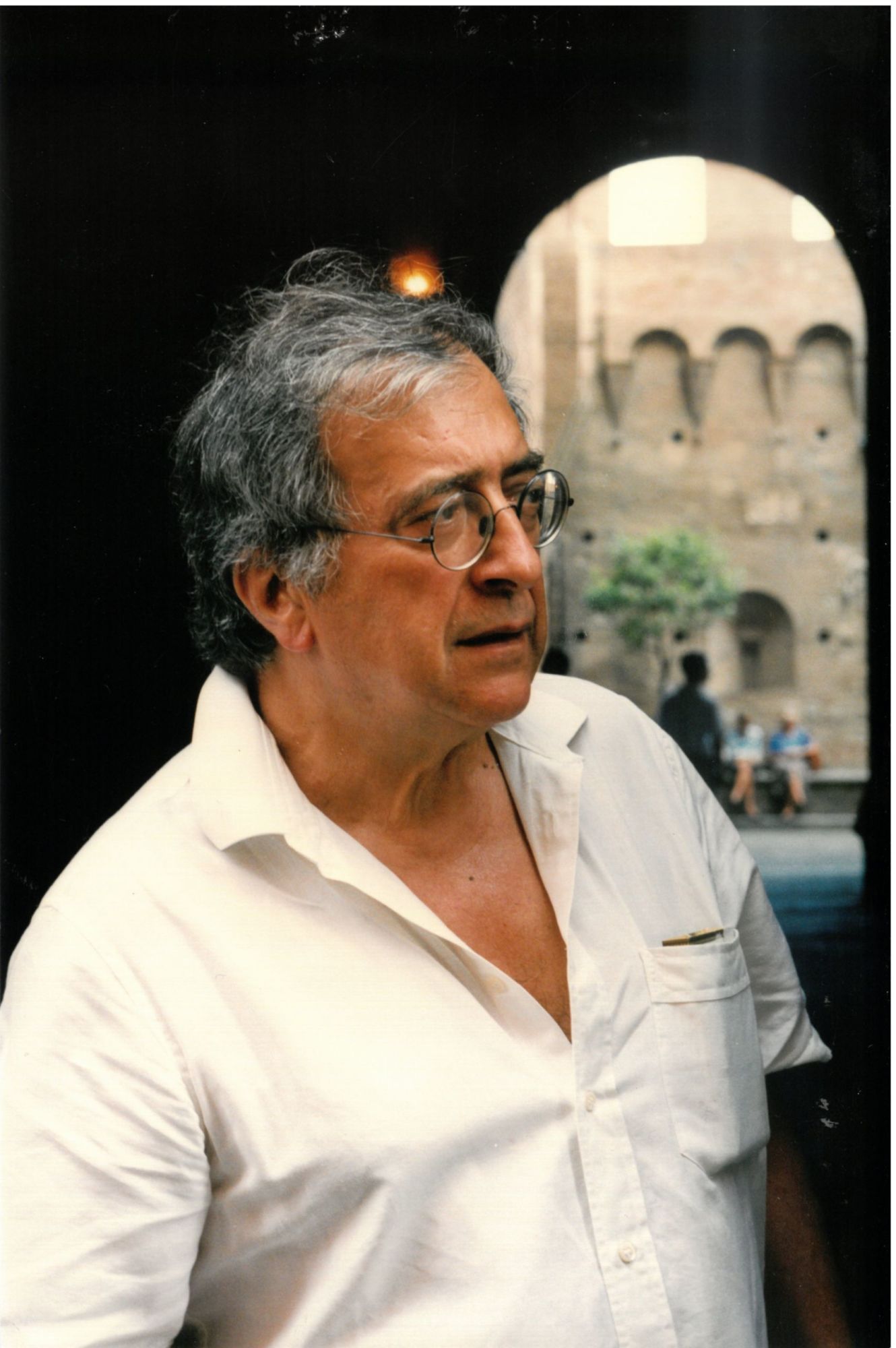
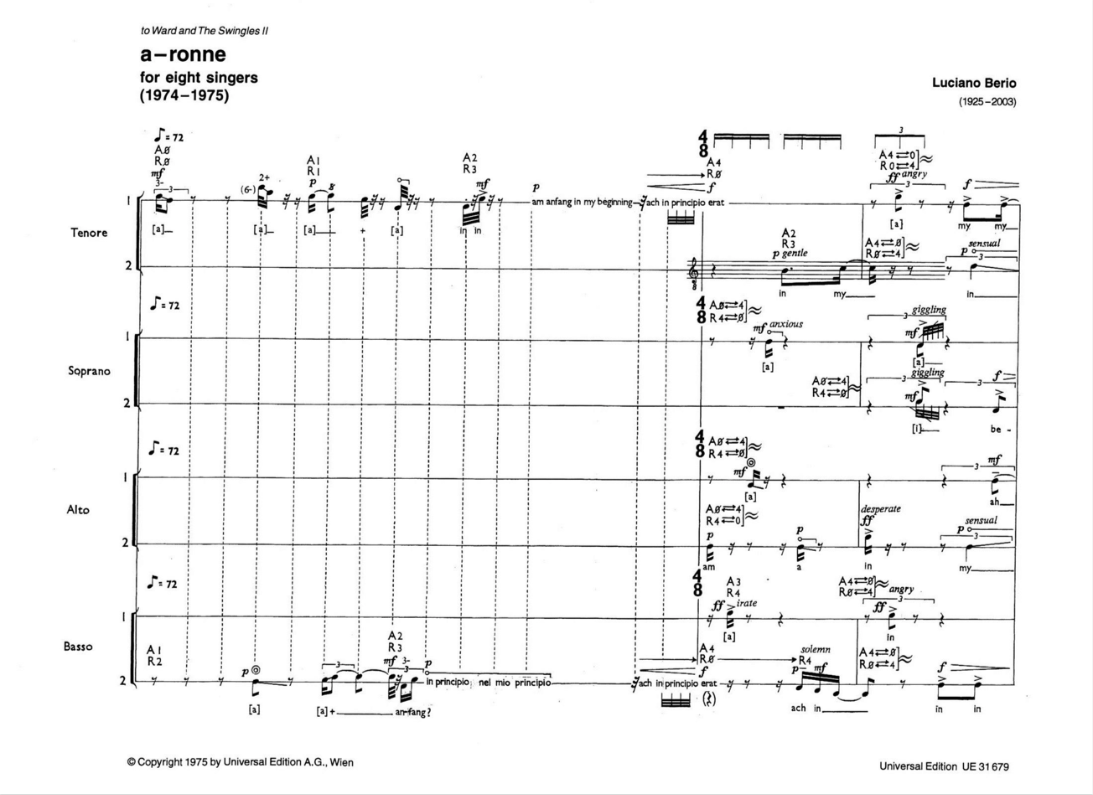
Luciano Berio, A-Ronne, © Universal Edition, A.G., Wien (1974-1975), p. 1
His investigation into the idiomatic potential of individual instruments began in 1958, with Sequenza I for flute, the series of 14 Sequenzas for solo instruments (the last, from 2002, is for cello). The set of these solo pieces and the related Chemins – elaborations for orchestral ensemble of some of the Sequenzas – highlights the peculiar work-in-progress character of Luciano Berio’s composing, potentially understood as an incessant process of commentary, development and creative (self-) analysis that continues and proliferates from one piece to the next. In the context of compositions for large orchestra, the composer explored new spatial arrangements (already experimented with in the 1950s in Allelujah Iand II) and new instrumental formations: Eindrücke (1973-74), Bewegung (1971/83), Formazioni (1985-87), Continuo (1989-91), and Ekphrasis (Continuo II, 1996). The dialectical relationship between solo instrument and orchestra is at the center of such works as Concerto for two pianos (1973);“Points on the curve to find…” for piano and chamber orchestra (1974), which merged intoConcerto II( Echoing curves) for piano and two instrumental groups (1988-89); Voci (Folk songs II) for viola and two instrumental groups (1984); Alternatim for clarinet, viola and orchestra (1994).In addition to the Concerto form, Berio reinterprets other historical genres such as the string quartet (Quartetto, 1956; Sincronie, 1964; Notturno, 1993; Glosse, 1997) and an instrument charged with traditional connotations such as the piano, which he investigated with unprecedented sonic, formal and expressive criteria in a series of works that from Sequenza IV (1966) leading to the acme of Sonata (2001).
What marks Berio’s musical approach is, on one hand, an intimate knowledge of tradition and, on another, an inclination toward new musical forms and experimentation. Throughout his many creative stages, Berio has always sought to strengthen the relationship between music and the other humanities: poetry, theatre, linguistics, anthropology, and architecture. Thanks to the breadth of his interest for vocal music at large, he consistently revisited works from various oral traditions (Folk Songs, 1964; Questo vuol dire che…, 1968; Cries of London, 1974-76; Voci, 1984). He explored the vast heritage of Western music in his readings of Claudio Monteverdi (Combattimento di Tancredi e Clorinda, 1966), Luigi Boccherini (Quattro versioni originali della Ritirata notturna di Madrid, 1975), Johannes Brahms (Op. 120 N. 1, 1986), Franz Schubert (Rendering, 1990), Wolfgang Amadeus Mozart (Vor, während, nach Zaide, 1995), Gustav Mahler (the two cycles of Frühe Lieder, 1986 e 1987), Johann Sebastian Bach (Contrapunctus XIX, 2001), Giacomo Puccini (il Finale di Turandot, 2001), alongside many others. This quest for juxtaposing distinct cultures’ many dimensions and traditions manifests itself additionally in works which indelibly marked the sound of vocal and orchestral music in the late 20th-century: works such as Sinfonia (1968), Coro (1975-76), and Ofaním (1988-92, revised in 1997), the latter of which sets the stage for his last two theatrical works.
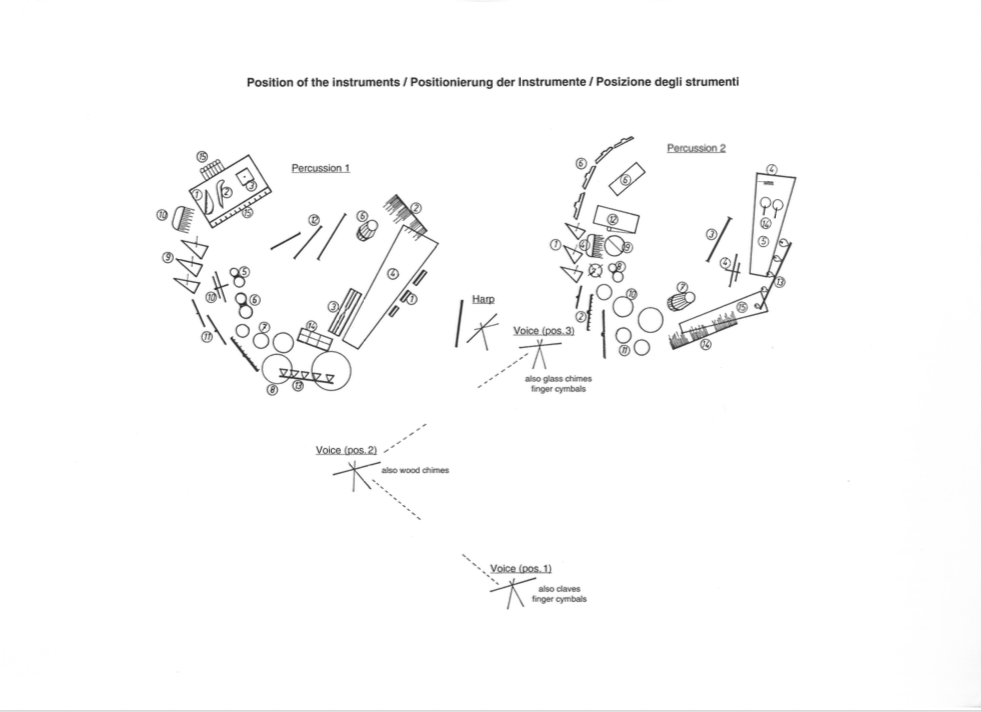
Luciano Berio, Circles, © Universal Edition Ltd., London (1960)
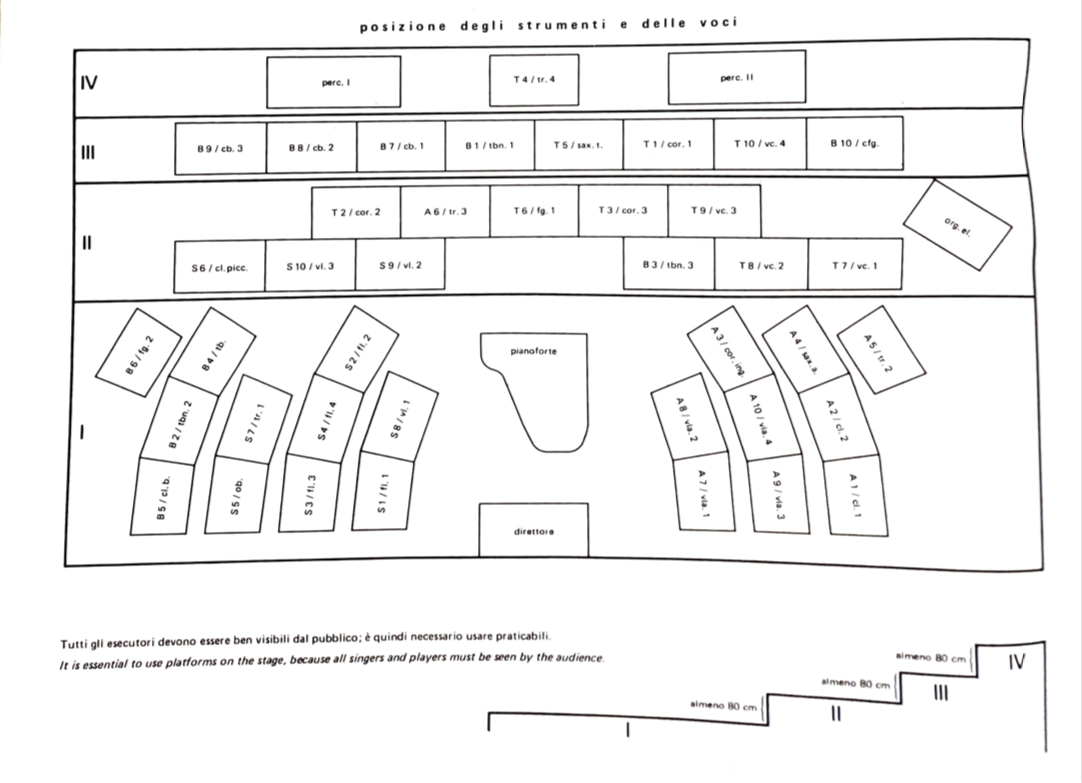
Luciano Berio, Coro, © Universal Edition, A.G., Wien (1975-1976)
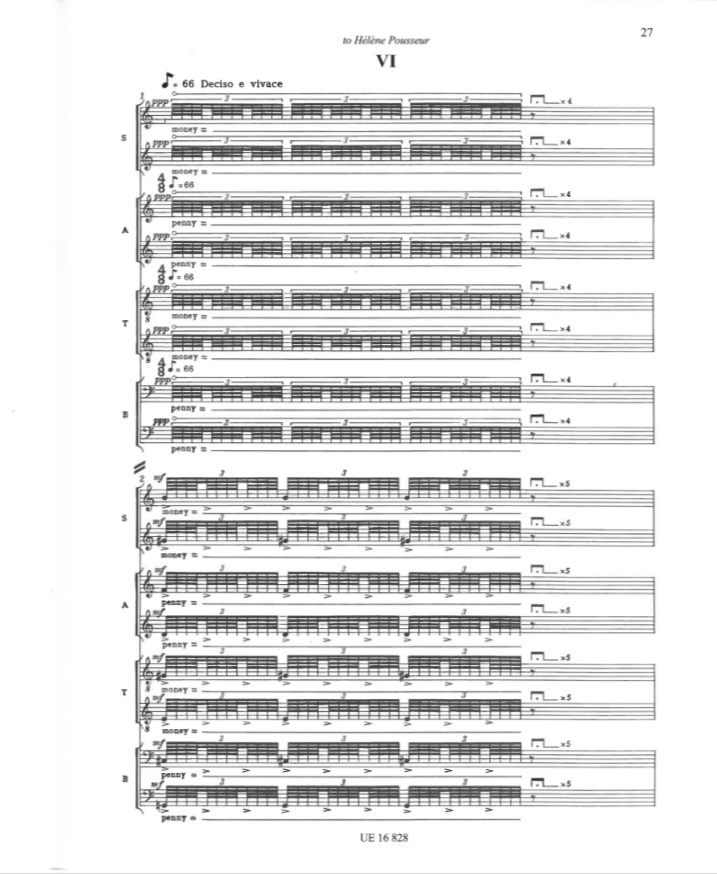
Luciano Berio, Cries of London, © Universal Edition, A.G., Wien (1974-1976)
It is precisely musical theater that constitutes a fundamental node in Berio’s research and poetics. After his first stage works in the 1950s and 1960s (the aforementioned Allez-Hop and Passaggio), he landed in the following decade with his first multi-act musical action on his own texts, Opera (1969-70/1977). This was followed by La vera storia (1977-79) on a text by Calvino; Un re in ascolto (1979-83) on texts by Calvino, Gotter, Auden and Berio himself; Outis (1992-96) on texts by Dario Del Corno; and Cronaca del Luogo (1997-99) on a text by Talia Pecker Berio. A-Ronne (1974-75), a radio documentary for 5 actors (elaborated in 1975 for 8 voices) on a text by Sanguineti, the culmination of the radio experiments conducted by Berio since the 1950s, deserves a special mention.
Luciano Berio passed away in Rome on May 27, 2003. In his last work, Stanze (2003, for baritone, three male choirs and orchestra, on texts by Celan, Caproni, Sanguineti, Brendel and Pagis) the composer gives voice to a last intimate synthesis of his own poetics. Berio’s commitment to music also extended to other activities such as conducting, conceiving concert seasons and promoting contemporary music (“Incontri Musicali,” a magazine and concert cycles inaugurated in 1956). He taught at prestigious musical and academic institutions in Europe and the U.S. (Darmstadt, Dartington, Tanglewood, Mills College, Juilliard School, Harvard University); his collaboration with the Accademia Chigiana dates to 2000. In 1993-94, he gave the Charles Elliot Norton Lectures at Harvard University. From 1974 to 1980, he directed the electroacoustic department of IRCAM in Paris, and in 1987 he founded the Centro Tempo Reale in Florence (a city where he had already led as the artistic director, between 1983 and 1984, the Orchestra regionale della Toscana and the XLVII Maggio Musicale Fiorentino). He was the recipient of numerous international awards (Siemens Prize; Wolf Foundation Prize; “Leone d’Oro” for Lifetime Achievement from the Venice Biennale; Praemium Imperiale of Japan) and four honorary degrees (City University of London and Universities of Siena, Turin and Bologna). Since 2000 he served as President of the Accademia di Santa Cecilia in Rome where, under his presidency, the new Auditorium Parco della Musica was inaugurated in 2002.
Angela Ida De Benedictis
PROGRAMMING OF THE FOCUS DEDICATED TO LUCIANO BERIO

